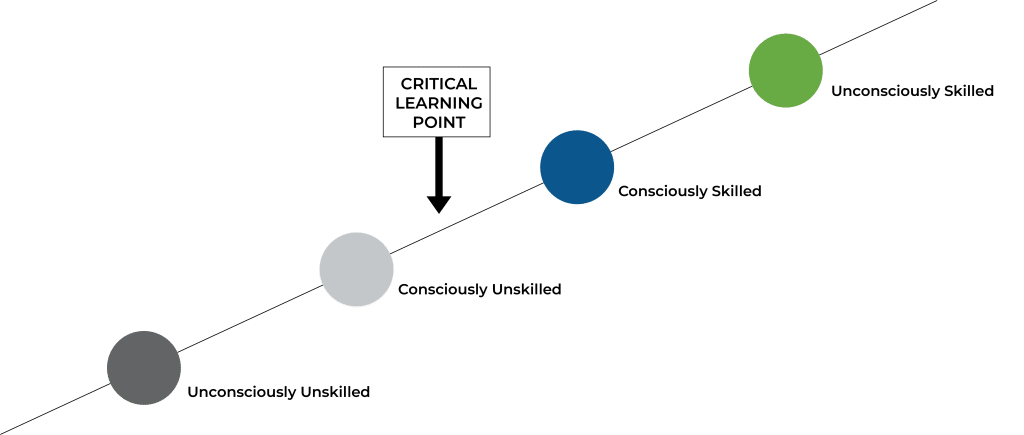
Charting the Course: Leadership Strategies for Managing Change in Education
Change is an inevitable force, presenting both challenges and opportunities for leaders and organizations alike. As education leaders navigate through the complexities of change, it’s imperative to understand the phases individuals undergo when confronted with change and how to effectively manage resistance.
Four Phases of Change
The Four Phases of Change, depicted below, provide valuable insights into individuals’ transition journey.

Phase 1: Unconsciously Unskilled
At the onset of change, individuals find themselves in a state of unconscious incompetence. They are new to a role, process, or skill, unaware of what they don’t know. This phase is characterized by a sense of unfamiliarity and perhaps a lack of confidence in navigating the new terrain.
Phase 2: Consciously Unskilled
As individuals progress, they enter a phase of conscious incompetence. They become aware of the gaps in their knowledge or skill set, recognizing the distance between their current abilities and the level required for success. This awareness often leads to feelings of uncertainty and a reluctance to fully embrace the change.
Phase 3: Consciously Skilled
With time and effort, individuals transition into a phase of conscious competence. They acquire the necessary skills and knowledge, though they may still require reminders or guidance to execute tasks effectively. Despite understanding the need for change, there may linger a sense of unease or resistance to fully embracing it.
Phase 4: Unconsciously Skilled
Finally, individuals reach a stage of unconscious competence. Tasks once deemed challenging become second nature, executed effortlessly and without conscious thought. At this stage, individuals have fully integrated the change into their routine and can navigate through it with ease.
Effective Strategies for Managing Resistance
Understanding these phases is crucial for education leaders as they navigate change within their school districts and organizations. When people resist change, it’s essential to employ effective strategies to manage that resistance:
Communicating with Clarity: Keep stakeholders informed about the reasons behind the change, its potential benefits, and how it aligns with the organization’s goals. Transparency fosters trust and minimizes uncertainty.
Engaging Stakeholders: Involve stakeholders in the change process by seeking their input, addressing concerns, and actively listening to their perspectives. When individuals feel heard and valued, they are more likely to support the change.
Provide Support and Resources: Offer training, resources, and support mechanisms to help individuals acquire the necessary skills and navigate through the transition effectively. Assisting demonstrates a commitment to their success and mitigates fears associated with change.
Address Concerns Empathetically: Acknowledge the valid concerns and apprehensions individuals may have regarding the change. Addressing these concerns with empathy and understanding can help alleviate resistance and foster a more positive attitude toward the change.
By embracing these strategies and fostering a culture of openness and collaboration, education leaders can effectively manage resistance to change and facilitate a smoother transition for their organizations.
Power of Reflective Practice
In addition to understanding individual responses to change, it’s equally important for leaders to facilitate reflection at both the individual and group levels. Reflection serves as a powerful tool for growth and improvement, allowing individuals and organizations to identify strengths, areas for development, and growth opportunities.
Through individual reflection, individuals can assess their current stage in the change process and identify steps they can take to progress further. Similarly, group reflection enables organizations to evaluate both individual and collective performance, pinpointing areas of success and areas that require attention.
Armed with insights gained from reflection, leaders can then take action, implementing adjustments, setting goals, and mobilizing their teams towards desired outcomes. By integrating reflection into their leadership practices, education leaders can harness the power of continuous improvement and drive positive change within their organizations.
As leaders of reflective practice, it is incumbent upon education leaders to structure these elements effectively, fostering an environment conducive to growth and innovation. Leaders can advance their organizations by embracing reflection, translating insights into action, and achieving goals.
KEY TAKEAWAYS
Think differently.
Embrace change as an opportunity for growth and innovation. Shift your perspective to see change as a catalyst for positive transformation. This mindset fosters curiosity, openness, and adaptability, enabling effective learning and growth amidst challenges.
Plan differently.
Acknowledge the significance of integrating resistance management strategies into your leadership approach. Prioritize developing comprehensive plans that address stakeholders’ concerns, offer support, and cultivate a culture of transparency and engagement, rather than solely focusing on implementing change initiatives.
Act differently.
Establish a structured reflection framework in your leadership practices, spanning both individual and organizational levels. Cultivate a culture of reflection to empower yourself and your team in identifying strengths, weaknesses, and improvement opportunities. Translate these insights into actionable steps, driving positive change and growth.




